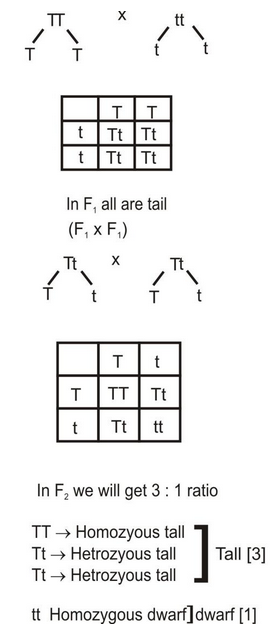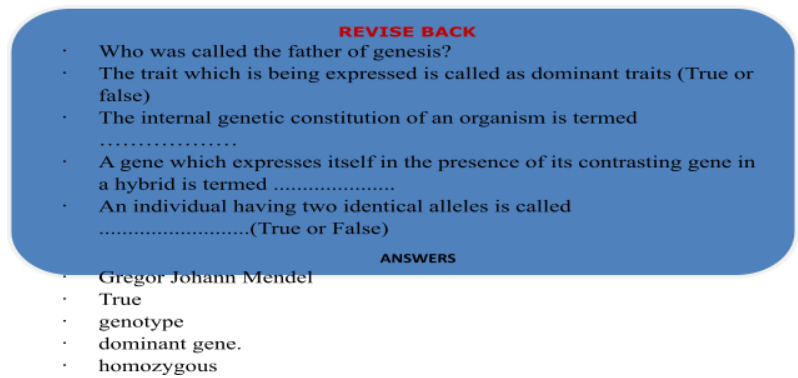
Mendal's Experiments And Laws Of Inheritance
Heredity And Evolution of Class 10
Mendal's Experiments And Laws Of Inheritance
Development of Mendel’s experiment’s
- Gregor Johann Mendel (1822-1884) was a monk (religious man) in Austria in 1843. In 1847, he became the head of Augustinian monastery at Brunn.
- In 1851, he went to the university of Vienna where he studied natural history and mathematics for two years.
- Mendel returned to Monastery in 1858. He also worked as a teacher of physics and natural history in a school from 1856 to 1865.
- Mendel conducted breeding experiments on garden pea in the garden of his monastery. Luckily he formulated the laws of heredity by his experiments and published his finding in a journal in 1866.
- His laws from the basis of the science of genetics and, therefore, he is remembered as the father of genetics.
- At the time of publication of Mendel’s research paper, Darwin’s theory of evolution was also in the air. So nobody concentrated on Mendel’s work. Mendel died in 1884 without getting any appreciation.
- In 1900, the Mendel’s work was rediscovered by three biologists de Vriesof Netherland, Carl Corrensof Germany and ErichronTshermakof Austria. A few years later, W. Batesonet al. confirmed Mendel’s work and found that same laws can be applied to animals also.
In human beings, the rules for the inheritance of traits are related to the fact that both the father and the mother contribute practically equal amounts of genetic material to the child. Each trait in the child is influenced by both paternal and maternal DNA (deoxyribo nucleic acid). In other words, for each trait, there will be two versions in each child, one from father and another from mother. Gregor Johann Mendel was the first scientist to work out the basic rules of such inheritance of traits more than a century ago. This involved the transfer of characteristics from parents to offspring. He did this by using different varieties of pea plants (Pisumsativum) which he grew in his garden.
Contrasting characters of pea plant studied by Mendel
- Plant height — Tall/short
- Flower colour — Violet/white
- Pod colour — Green/yellow
- Pod shape — Smooth/wrinkled
- Seed colour — Green/yellow
- Seed shape — Round/wrinkled
Some general terms used by him are :
Genotype. The internal genetic constitution of an organism is termed genotype. Environment has no effect on it.
Filial generation. The generation of offsprings is termed filial generation.
First filial generation (F1). The first generation of offsprings produced form parent generation.
Second filial generation (F2). The second generation of the offsprings.
Monohybrid cross . A cross between parents differing in one trait or in which only one trait is studied.
Dihybrid cross. It is a cross between two organisms of the same species which is made to study inheritance of two pairs of factors or genes.”
Phenotype. It refers to externally visible characters of an organism. It is the net result of interactions between genotype and environment. Individuals of the same genotype breed alike termed phenotype.
Genome. A complete set (n) of chromosomes inherited as a unit from one parent is termed genome.
Gene. A hereditary determiner specifying a biological function; a unit of inheritance (DNA) located in a fixed place on the chromosome is called gene. Gene represents factor used by Mendel.
Factor. Discrete heredity information called as factor by Mendel.
Dominant gene. A gene which expresses itself in the presence of its contrasting gene in a hybrid is termed dominant gene.
Recessive gene . It is that gene whose expression is suppressed in the presence of dominant gene e.g., In a hybrid (Tt) tall plant, t gene for dwarfness is recessive and T gene for tallness is dominant.
Alleles. Two alternative genes at the same locus in homologous chromosomes are termed alleles. It is an abbreviated form of allelomorph.
Heterozygous. An individual having two different alleles for a particular character is called heterozygous or hybrid (Tt).
Homozygous. An individual having two identical alleles is called homozygous (TT or tt).
MENDEL'S EXPERIMENTAL PLANT:
Mendel selected garden pea plant (Pisumsativum) for series of hybridization experiments because it had the following special features:
(i) It had a short life cycle and, therefore, it was possible to study a number of generations quickly.
(ii) Garden pea plant had distinct, easily detectable contrasting variants of features. For instance, some plants were tall and some dwarf; some had violet flowers and some had white flowers; some plants had round seeds and some had wrinkled seeds and so on. Mendel, in fact, noted seven pairs of such contrasting characters in garden pea plant.
The characters which always appear in two opposing conditions are called contrasting characters.
The traits and their contrasting forms are shown in the following table
CONTRASTING CHARACTERS SELECTED BY MENDEL FOR HIS EXPERIMENTS
Trait Dominant form Recessive form
Height Tall (T) Dwarf (t)
Position of flower Axillary (A) Terminal (a)
Colour of unripe pod Green (G) Yellow (g)
Shape of unripe pod Inflated (I) Constricted (i)
Colour of seed coat Coloured (C) White (c)
Colour of cotyledons Yellow (Y) Green (y)
Form of seed Round (R) Wrinkled (r)
(iii) All the contrasting traits existed in every generation because plants had bisexual flowers and normally resorted to self-pollination.
(iv) In these bisexual plants, artificial cross-fertilization could easily be achieved. It was done by removing the stamens (male part) before maturity of the female part of flower and later dusting the pistil (female part) of this flower with the matured pollens from a desired plant.
(v) Each pea plant produced many seeds in one generation.
(vi) The garden pea plants could easily be raised, maintained and handled.
CROSSING TECHNIQUE EMPLOYED BY MENDEL:
Since garden pea is self − fertilizing, the anthers have to be removed before maturity. This operation is called as emasculation. The stigma is protected against any foreign pollen with the help of a bag The pollens then at the dehiscence stage, is brought from the plant to be used as male parent and is dusted on the feathery stigma of the emasculated flower. At the time of pollination, the pollens should be mature and the stigma should be receptive.
Emasculation
↓
Bagging [for protection]
↓
Dehiscence [by dusting pollens]
↓
Pollination
(i) Traits chosen by Mendel for his experiment: There are seven traits which Mendel has chosen, they are as follows:
|
S.No. |
Characters |
Dominant |
Recessive |
|
1. |
Stem height |
Tall |
Dwarf |
|
2. |
Flower colour |
Violet_ |
White |
|
3. |
Flower position |
Axial |
Terminal |
|
4. |
Pod shape |
Inflated |
Constricted |
|
5. |
Pod colour |
Green |
Yellow |
|
6. |
Seed shape |
Round |
Wrinkled |
|
7. |
Seed colour |
Yellow |
Green |
Mendel performed experiments in three stages:
(A) He made sure that, the plant which he had chosen must be a true breeding plant, by letting the plant to undergo self - fertilization.
(B) He performed the process of cross pollination of alternate forms of traits. The resultant generation obtained was termed as hybrid and these hybrids formed are called F1 generation i.e, first filial generation.
(C) He allowed the hybrids to self pollinate up to five generations and these generations are subsequently termed as F2, F3 F4 and so on.
Precautions taken during experiment
While performing his cross breeding experiments, Mendel took a number of precautions.
(i) He always focused on the inheritance of the specific traits under consideration and simply ignored others. For instance, in his crosses, only one trait, i.e., size of plant (tall or dwarf) or colour of flower (violet or white) etc. was considered. He called such crosses as monohybrid crosses. Mendel also conducted crosses considering two or more contrasting traits of garden pea plant simultaneously. He designated such crosses as dihybrid crosses, trihybrid crosses and so on.
(ii) In cross breeding experiments, most important precaution required is to avoid self-pollination between two varieties or traits of plants. Mendel removed the anthers (male parts) of the flowers well before the maturity of the female part, i.e., gynoecium of the flowers. This process is called emasculation. Such flowers were covered to avoid entry of any foreign pollen grain from outside by wind or animals. For making desired cross, mature pollen grains from the anther of the flower of the desired plant were transferred on the stigma (female part) of the emasculated mature flower. The seeds formed by such crosses were collected. These seeds belonged to the first filial generation or F1generation. To draw effective conclusions, Mendel used the seeds of F1 generation to raise the F2 generation by self pollination and also the F2 seeds for raising F3 generation by self-pollination.
(iii) He maintained all the records of his experiments.
Result's of Mendel's Experiments:
(A) When the self pollination was made and F1 generation was obtained, it was found that the generation would express only one of the trait and not the other. The trait which is being expressed is called as dominant, whereas the one which is not expressed is called as recessive trait.
(B) In the F1 generation obtained by self pollination, the dominant and the recessive traits obtained were in the ratio of 3 : 1 i.e. 75% of the offsprings which appeared in F1 generation had dominant trait, while 25% had recessive trait. This ratio of 3 : 1 is also said to be known as Mendelian monohybrid ratio.

Homozygous tall : Heterozygous tall : Homozygous dwarf
1 : 2 : 1
(C) Mendel further found that the phenotypic ratio of 3 : 1 of dominant to actually a genotypic ratio of 1 : 2 : 1 of pure dominant, hybrid and pure recessive forms traits which remain hidden in F1 generation got expressed in F2 generation. This was later proved in F3 generation.
Reasons for Mendel's success:
- He selected true breeding (pure) pea plant for his experiment.
- He studied single trait at a time.
- He kept an accurate mathematical record of his breeding experiments and noted down the number of each type of offspring produced in each cross.
- He was lucky enough to select the seven traits, as the gene for these traits are located on four different chromosomes.







